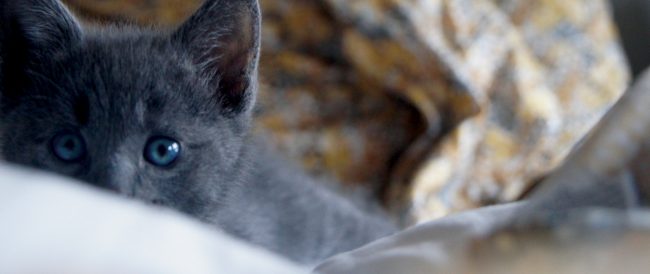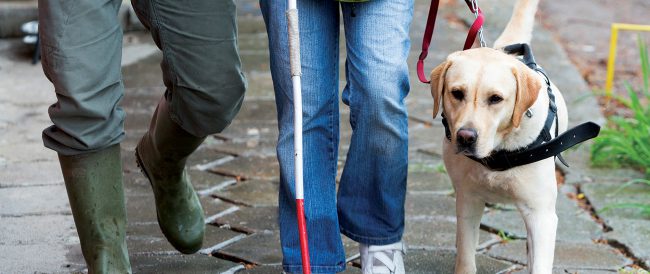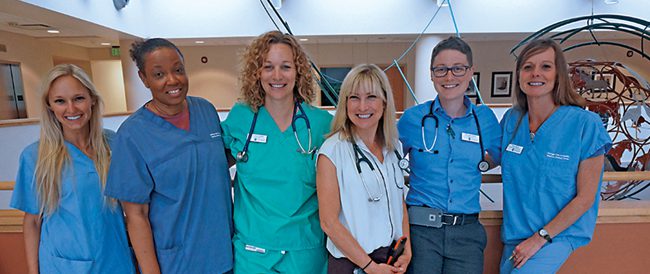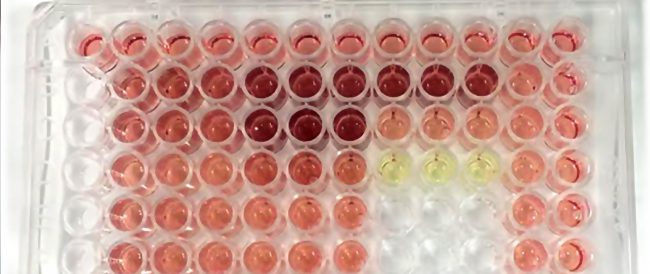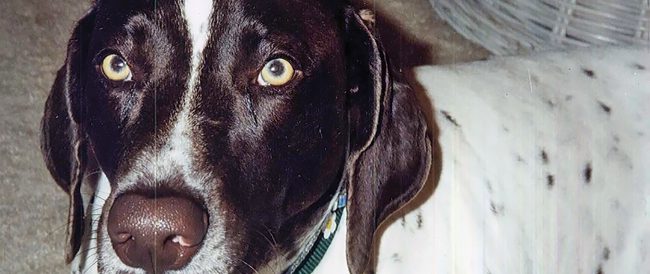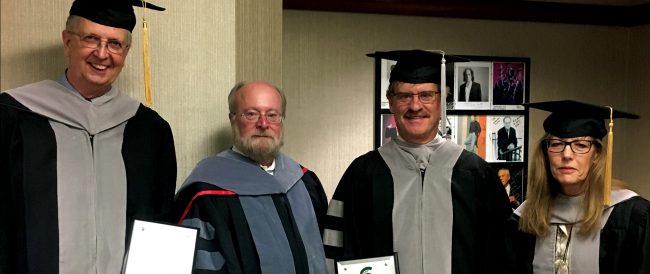 Read More
Read More
On the whole, dog owners know the special feeling of arriving home and being showered with excited affection; it feels like the best part of their dog’s day. Jim and Barb Edgett are familiar with the warm feelings of joy and love that come with welcoming a dog into the family.

The Edgetts have been married for 61 years—together ever since a blind date in high school—and it was Jim who introduced German Shorthaired Pointers into their lives. He had fallen in love with the breed years before, when his father was given one, and had two of his own before he married Barb. Daisy came to Jim and Barb as their fourth German Shorthair Pointer together. “She was probably one of the most outgoing, loving dogs we’ve ever had,” says Jim. “She loved everybody, loved other dogs, loved people.”
The Edgetts also are loyal Spartans, even though neither attended Michigan State University as students. Before they retired, the pair ran a moving company, which shipped everything from bulldozers to toilet paper and personnel all over the world for MSU. That relationship evolved throughout the years, and the Edgetts became avid sports fans. They decorated their homes and cars with the MSU colors. “We couldn’t be prouder to be Spartan fans,” says Jim.
The Edgetts have a special relationship with the MSU College of Veterinary Medicine, which began long before they ever brought Daisy to the MSU Veterinary Medical Center. It was in 1999, following their passion for animals, that the Edgetts first took a tour of the Small Animal Clinic and began supporting the Hospital. However, they never had occasion to bring any of their pets to the Hospital until Daisy was diagnosed with cataracts many years later.
All older dogs—usually beginning at around six years of age—develop nuclear sclerosis, a hardening of the lens, which causes the eye to have a grayish and cloudy appearance. It is extremely difficult to tell the difference between normal nuclear sclerosis, which does not usually interfere with vision, and cataracts, which does.
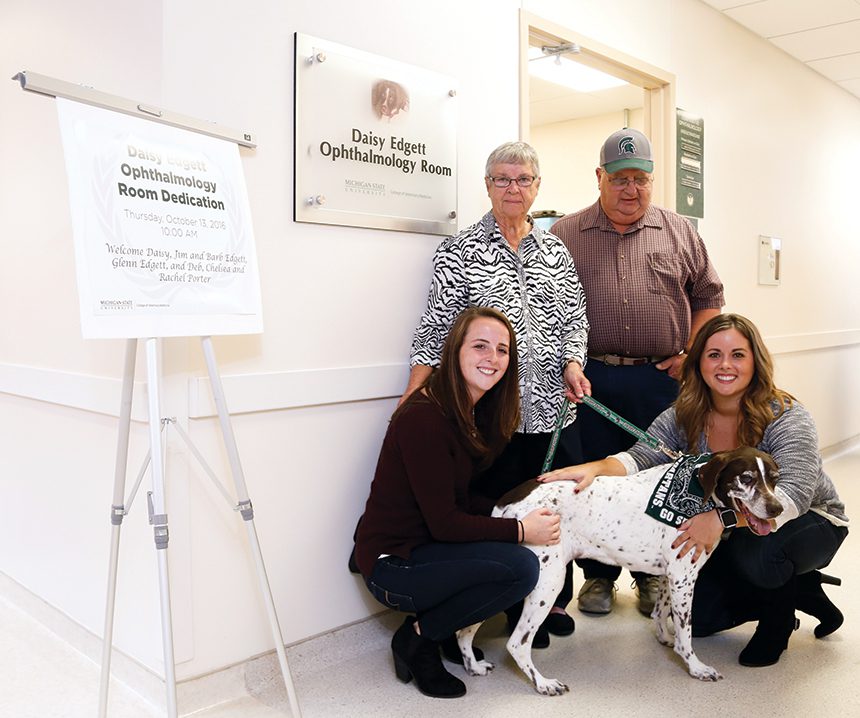
Cataracts, while not always severe enough to result in complete loss of vision, are the most common cause of blindness in dogs. Treating them requires specialized equipment used by a veterinary ophthalmologist. A thorough evaluation is necessary when deciding if a dog is going to need and be a suitable candidate for cataract surgery. There is an optimal window of time during which to perform the surgery, and the earlier it can be done, the better.
When the Edgetts first suspected Daisy was going blind, they were in Florida. They took her to a local veterinarian, who recommended immediate action to prevent Daisy from completely losing her vision. “We were scared and hopeful her cataracts could be taken care of,” says Barb. “Our first thought was to bring her back to MSU.”
Daisy’s Story
In May of 2012, the Edgetts brought Daisy to MSU’s Comparative Ophthalmology Service, and her diagnosis of cataracts was confirmed. For Daisy’s safety, additional medical treatment was needed before cataract surgery could be performed. Unfortunately, before the procedure could safely take place, Daisy’s cataracts became inoperable and resulted in the complete loss of her vision.
Despite Daisy’s outcome, the Edgetts say they had a good experience at the Hospital. They formed attachments to the veterinary staff, including several long-lasting relationships. When they were able to take Daisy home, the Edgetts knew they wanted to help other animals and their human families in similar situations.
Giving Back
“We decided that if we gave money to MSU that would help other animals, then that would be the thing to do.”
— Jim Edgett
Both Jim and Barb were raised with the mentality that you should give back. They consider themselves fortunate to be in a position where they can do just that. “We decided that if we gave money to MSU that would help other animals, then that would be the thing to do,” says Jim.
During their time at the Hospital, the Edgetts learned the Ophthalmology Service was in need of funding for new equipment. They decided that would be the best place to offer their support. The Edgetts called Dr. Simon Petersen-Jones, section chief and Myers-Dunlap Endowed Chair in Canine Health, and asked what he needed. With his wish list and the Development team’s guidance, the Daisy Edgett Ophthalmology Room was created. It’s filled with the most advanced equipment funded by the Edgetts, which makes the Hospital’s Ophthalmology Service one of the best in the world.
“It was completely selfless,” says Dr. Petersen-Jones, with whom the Edgetts formed a particularly close relationship. “They wanted to see other pets benefiting from our service in a way that Daisy no longer could.”
The Edgetts have continued to offer their support, providing funds to purchase additional equipment and fulfill wish lists for Drs. András Komáromy and Chris Pirie, also on MSU’s Ophthalmology team. They have also worked with Development to set up multiple planned gifts for the future.
The Edgetts say that working with the Hospital has been a fulfilling experience, especially seeing how their gifts are being used. They loved seeing Daisy’s room completed and were pleased to watch as a dog was evaluated using the new equipment. “It makes us happy that it’s being used for a purpose we believe in,” says Barb.
A Lasting Impact
Daisy Edgett: A Life of Love
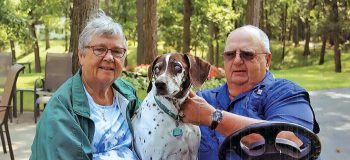
On average, German Shorthaired Pointers live to be 12–14 years of age. Daisy, despite being blind for the last 5 years of her life, lived to be 14, passing away on October 27, 2017.
She was one of the happiest and most outgoing dogs the Edgetts ever welcomed as a part of their family.
She loved taking boat rides down in Florida, where dolphins came right up to the boat and she delighted in being the first to see them.
In Michigan, she loved being in the water and at big family events, where she could be surrounded by people she loved and who loved her.
Her favorite napping spot was cuddled up in bed with Jim and Barb, tucked between the people she loved most.
Five years after the Edgetts brought Daisy to MSU, she passed away. At home, the Edgetts are surrounded by pictures of Daisy. They set up a memorial to her outside their kitchen window—a stone etched with her name and a flower pot filled with daisies. At the Hospital, Daisy has another memorial. There is a sign that bears her name and picture, hung proudly on the wall for all to see.
It gives the Edgetts comfort to know that Daisy will be remembered; that through their gifts and their impact on all those who come to the Hospital for help, she will never be forgotten. “We won’t be here,” says Jim. “Our dog won’t be here. But she will be in MSU’s facility forever.”
The Edgetts’ love for Daisy shines through their voices when they speak of her, and her love for them is clear to anyone who watched them together. This incredibly strong bond between owners and their animals extends beyond the confines of a single human-animal relationship, beyond the boundaries of a single family. It extends to include other animals, to encompass other animal owners. Those who know what it is for an animal to become a part of their family, to feel that deep and undying connection, will always share that understanding.
Through their support of the Hospital, Jim and Barb have provided help to others who have opened their homes and their hearts to dogs. They have ensured that not only will they always remember Daisy, but that all those in a similar situation who come seeking help also will remember her.
Daisy’s happy face, eyes glowing and ears flopping, looks over all those who visit the Daisy Edgett Ophthalmology Room. She was a bright light in Jim and Barb’s lives, providing laughter and love. Now, through the support the Edgetts have provided in her name, her light continues to shine.







